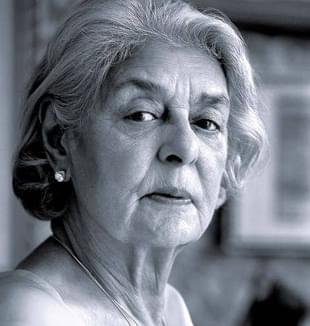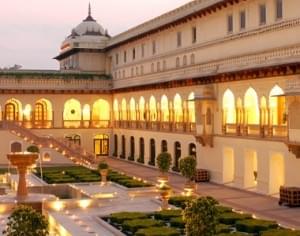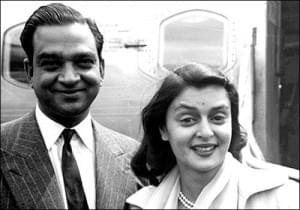Reviews
Maharani Gayatri Devi: Abiding Beauty
Amarnath Govindarajan
Feb 14, 2012, 12:54 PM | Updated Apr 29, 2016, 02:36 PM IST
Save & read from anywhere!
Bookmark stories for easy access on any device or the Swarajya app.


I believe it was love at first sight. Right there in front of my eyes perched adjacent to an abominable volume on Atkins diet was this bright orange book with a typical Mughal style window art in yellowish colour to contrast with the background. In the middle read the title: “A Princess Remembers: The Memoirs of the Maharani of Jaipur”.

There was no way I was going to leave this little volume by the legendary lady politician Maharani Gayatri Devi of Jaipur lying amidst dusty old editions of Atkins diet, evangelical cargo cults and how-to-speak-French-in-21-days. Realising she needed rescue I quickly picked up the book and gently (perhaps affectionately) tapped the dust off the cover. Then, I sallied forth to engage the sales guy for a customary haggling but the philistine only asked for Rs.30. The ignoramus had judged the monetary value of the volume by its weight.
The old bookshop man was in-fact right. The book is rather light weight both in the gravitational sense and in terms of readability. However, hurriedly shuffling through the book one does get besotted by the sheer charm that exudes through the lady’s memories. It’s hard to tell what constitutes this element of charm. Whether it was the colonial past, the Royal-connection, the Maharani’s enticing personality or mischievous wit that comes through her text one cannot say. And yet throughout her memoirs there lingers in the readers mind certain empathy and even a sense of affection.
The memoir begins with a description of Gayatri Devi’s childhood train journeys that would take the royal family of Cooch Behar to visit their maternal grandparents the Maharaja and Maharani of Baroda. There is much to be delighted and amused about in the Princess of Cooch Behar’s narration of the train journey. The fuss her mother makes about gold tongue scrappers, tiffin-carriers, lunch breaks at remote stations, luxurious coaches and the retinue of personal servants and secretaries all make for quaintly idyllic imagery. Even before the reader recovers one is introduced to the grandeur of Baroda Laxmi Vilas palace, the Maharaja and Maharani of Baroda, and the love-story of her parents that nearly rivals her own!
But before we get to the love stories, and I don’t know why nobody has made a period movie on these romances, there is this slight discomfort at the sheer opulence of Indian Royalty. It is hard not to contrast the lives of the Maharaja’s with that of their subjects and wonder if the aristocracy were really living in another world!
Perhaps this author can be accused of succumbing to the base instincts of egalitarianism – maybe even a tinge of jealousy, disdain even. Perhaps I could be guilty of encouraging that common line of socialist thought; questioning if the Royal’s deserved a lifestyle immersed in such sumptuous stately grandeur at a time when (in our popular imagination) their contemporary Indian peasant, (who was paying for all of it mind you) struggled through a miserable existence, one drought away from certain death.
Perhaps I’m not over-exaggerating. The sheer scale of lavishness the Maharani was born, brought up and wed into simply remains a source of undiminished astonishment. The Maharani’s family and the lady herself are holidaying in Europe for half the year. There is talk of Bentleys, gambling casinos and endless ‘entertaining’ of guests. When they seem to have run out of guests to entertain in Europe they entertain guests in India flying to and fro in private jets or chartered ships from P&O suitably modified for the royalty. It is hard to see when the Royalty would be able to find the time to govern. Perhaps they didn’t. There is always some stately occasion or colourful festival where dozens of elephants kept for ‘ceremonious’ occasions are brought out and processioned. Gold coins are thrown out to the crowds. When somebody weds the ceremony finds a mention in the Guinness book of world records as the costliest wedding ever.

As if to assuage one’s guilt of entertaining a tinge of envy the lady herself describes her astonishment caused by the Jaipur palace store-rooms. She finds supplies of ‘wines, spirits, cigarettes, tea, biscuits, shampoo, Christmas crackers…toffees, chocolates and so on’. She hears of the maids and the maids dogs helping themselves to ‘Evian’ water imported from Europe presumably for one of the Maharanis. The ‘Third Highness of Jaipur’ as Maharani Gayatri Devi was officially titled then brings to bear all her European training in domestic skills to bring down the Jaipur Rambagh expenses to half of the original before she arrived. The lady was trained for such duties and other things as she spent her formative years schooling in Europe stories of which inevitably lead us to the famed romance between this Princess of Cooch Behar and the Maharaja of Jaipur.
The romance between Sawai Man Singh II, the Maharaja of Jaipur and Princess Gayatri Devi are simply put the stuff of movies and legends. The romance and courtship are stylishly old school adding much warmth and charm to the memoir. There are the usual letters stolen across without the ADC’s knowledge, the secret dates, movie outings, a disapproving parent and other such assorted issues that make a teen-age romance(at-least for the Princess). The Maharaja always cuts a large than life figure throughout the memoir. He supports Gayatri Devi slowly dismantle the notorious tradition of Royal household women remaining out of sight of everybody else – the purdah. It would even seem that the marriage was also of some utilitarian value to the Maharaja who had married twice before, both the alliances carefully arranged by his father.
The ‘First and Second Highnesses’ remain in purdah and perhaps that prompted the European educated Maharaja to find in Gayatri Devi a consort to share his passion for sports, hunting and ‘entertainment’. But it isn’t a selfish marriage where a besotted Princess finds her love and then lives in the shadow of a Maharaja for the rest of her life. When Gayatri Devi signs up to politics we find the Maharaja quietly (and sometimes not so quietly) backing her in the Maharani’s endeavours without choosing to interfere or influence her politics or public life.
It is easy to see why the Maharani of Jaipur would be pushed towards entering politics opposing the then dominant Indian National Congress (INC). Her husband’s role in state affairs were on the decline, so was the prestige of the royal family. The manifest corruption and nepotism prevalent in the new ruling classes must have added to the abhorment. In one instance the Maharani is reduced to pleading for an appointment with the state Chief Minister to protest against the vandalisation of Jaipur’s historic features. Gayatri Devi quite presciently for her time tells of how the Congress had long since morphed into the ‘Establishment’.
For the chattering classes of Delhi such an statement would cause much contrived earnest ‘discussion’, with facial expressions resembling an acute case of constipation. The Establishment on the other hand for reasons of its own remains envious of the erst-while nobles. Like all Establishments it attempts to co-opt the Royals lest they become trouble makers.
In 1956 the Maharaja of Jaipur is informed that he shall cease to be the Rajapramukh of the Rajputana states. Jawaharlal Nehru’s response to Sawai Man Singh II’s letter expressing distress at the unilateral manner in which such a momentous decision was taken is revealing of the hubris and haughtiness that had set in. India’s unchallenged first Prime Minister had curtly written that “the Constitution cannot be petrified”. The Royals appeared to have got the message. By now much of the old pomp and grandeur had begun to give way to ‘new reality’. The Rambagh palace is converted to a hotel, extra staff is pensioned off, the private plane reluctantly given up and even the philkana emptied.
Perhaps the impending visit of Queen Elizabeth II and Prince Philip caused Gayatri Devi to juxtapose the status of British Monarchy with that of her own household’s. Or perhaps the Establishment had simply annoyed her enough at both personal and political levels. The Maharani had clearly had enough. She asks her husband if signing up to the Swatantra Party would be okay, and is given assent in an almost absent minded casual manner. In keeping with the Royal style-guide the local Swatantra chap is summoned for a breakfast and forms are signed. When Rajaji writes expressing his thanks and appreciation describing her move as ‘brave’ the Maharani confesses not realizing the troubles she was getting into.

When Gayatri Devi is asked to contest for the Lok Sabha from Jaipur constituency she confesses not to have aspired for office. A politician’s typical denial of ambition? To this author the confession seems earnest. Politics to Gayatri Devi was her way to give pronouncement, to give form and venue for her resentment of the Establishment. The resentment was perhaps caused both by her loss of prestige and a sense of independent India not delivering on the promise of governance. But this is not to say that the higher political questions such as Rajaji’s opposition to Nehru’s statism and utopian collectivism did not feature in her thought. They did. However what moved her seems to be the resentment.
The memoirs speak of two elections in 1962 and 1967. The Maharani’s first election campaign finds detailed narration and mention, particularly of her having to abandon the comforts of her palace and having to travel far into rural hamlets. She doesn’t seem to mind the troubles, in-fact she seems to have settled into the campaign routine rather well. Once again a sense of disappointment towards the royals is unavoidable. Until the election campaign there are no mentions, not even the briefest of them, about the interiors of the state territories and their generally impoverished state. It is not as if the Jaipur rulers had totally shirked their responsibilities, there is indeed ample evidence of their affection towards their subjects, but nevertheless one cannot but wonder if the princely rulers would not share the blame for the backwardness of their populace.
She wins her first polls with an astounding majority and the Jaipur royals find their name in the Guinness records: an election victory with a majority of over 1,75,000! The previous occasion that caused their names to appear was the wedding of Sawai Man Singh II’s daughter – dubbed as the costliest ones to have occurred! What follows is a litany of issues Gayatri Devi has to battle, all petty or things out of her control leaving behind only a depressing sense of helplessness. She might be the M.P of Jaipur what exactly could she do about prices of food items or a legislation that is being bulldozed through the Parliament by the Congress? She might have been the erst-while Maharani, the local celebrity object of much attention and affection but in New Delhi she becomes one of the 534.
We hear of how the Establishment has gotten wise by the time of next elections. There is a ‘delimitation’ exercise, perhaps inspired by the egalitarian Congress conception that no single candidate may garner all the vote. This leaves very little of the original Jaipur areas in the new Jaipur parliamentary constituency. It appears the trick worked. Gayatri Devi’s majority is much reduced but she manages to keep the seat anyway. In the case of the local legislative assembly front the Maharani describes how a certain Congress appointed Governor (who replaced the Rajpramukh) sabotages the formation of a Swatantra government in state. The narration which includes details of unnecessary police firing, causalities and the archetypal parade of M.L.A’s for a ‘headcount’ before those that matter. It makes for a depressing reassurance of the unchanging nature of the Establishment that continues to govern India.
The Swatantra Party represented perhaps the only chance for the old establishment to channel their energies into a Conservative political movement in India. It could have taken on the role of opposing the INC piloted drive towards a Socialist utopia. Though it was representing an economic and social outlook far ahead of its time for the Indian electorate one is left wondering if it was the very social constitution of the Swatantra that caused their failure. The Swatantra leadership to a large extent was drawn from the erstwhile nobility, big business and ‘upper caste’ strata of the then society. Did they suffer political setbacks for their inability to rise beyond old fashioned ideas of propriety, a sense of public decency and idealism? They may have set out for the Senate but ended up fighting the Establishment gladiators in the arena. A fight they could only lose. But this is the story of the Maharani and we shall return to it.

Beginning from the last years of the sixties there doesn’t seem to be many happy tales for lady to narrate. The Maharaja Sawai Man Singh II dies in a polo match, and in only a couple of years the Parliament moves the twenty sixth amendment that denied the princes their privileges, titles and privy-purses. Here is the irony: even as the twenty sixth amendment is being subject to Parliamentary process the then Maharaja of Jaipur Sawai Bhawani Singh would be fighting for many days well inside enemy territory as part of the famed Parachute Regiment. The movers of the twenty sixth amendment on the other hand would go on to found and lay the basis for a new dynasty to rule India! (He had earlier kitted up the men with his own money when standard issues were found to be out of date.)
Maharani Gayatri Devi herself would face an imprisonment and much harassment before her retirement from active politics. But all of that are spared the reader of this memoir published in 1976. It is hard to end the memoir on anything but a sad, disheartening note yet it is important to celebrate this personality.
Gayatri Devi represents that class of politician who despises the rejection of common sense for easy utopianism and empty idealism. The legacy she has chosen to leave behind are her schools, museums and parks. The political legacy of Gayatri Devi and others like her from the princely class on the other hand, are yet to be fully nurtured and woven into our popular political discourse. What remains are fragments, previews and anecdotes not completing the picture. This ought to be taken up. A story replete with grandeur, beauty, nostalgia, tradition and valor. What a worthy endeavor it would be to tell it!





